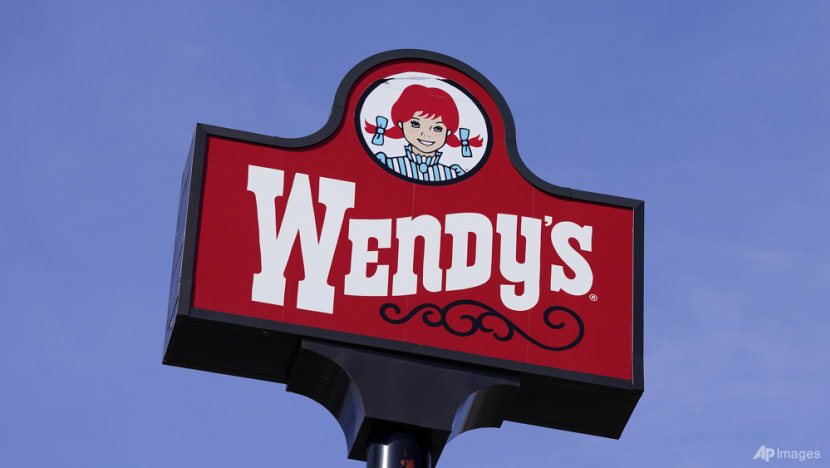Commentary: Surge pricing for fast food is a terrible idea – just look at the Wendy’s backlash
Turns out the recent brouhaha about fast food chain Wendy’s plan to introduce surge pricing was based on a misunderstanding. But it also sends a message to food companies, says Tracy Lee.

A sign stands over a Wendy's restaurant in Des Moines, Iowa. (Photo: AP/Charlie Neibergall)

This audio is generated by an AI tool.
SINGAPORE: Two things people expect about fast food, are that it’s meant to be fast and cheap. But is surge pricing coming for our burgers and fries?
American consumers were up in arms last week when burger chain Wendy’s said it was looking to test features like “dynamic pricing and daypart offerings”, as well as “AI-enabled menu changes and suggestive selling” as early as 2025.
Most of the outrage was directed at “dynamic pricing”, which was re-interpreted more specifically to mean “surge pricing” with price hikes at times of high demand, especially with biting inflation and rising food prices over the past few years. Netizens rallied to #BoycottWendys and an American senator called it “price gouging, plain and simple”.
The commotion led Wendy’s to quickly reassure customers that the new technology would be used to offer discounts more easily and that it “would not raise prices when our customers are visiting us most”.
But to be fair to Wendy’s, “dynamic pricing” is not quite the same as “surge pricing”. Though people tend to use the terms interchangeably, a kinder read of CEO Kirk Tanner’s words might differentiate dynamic pricing as the broader act of changing a price multiple times which could include lower prices when demand is low – not just higher prices when demand is high.

SINGAPORE NO STRANGER TO DEMAND PRICING
Though Wendy’s no longer has a presence in Singapore, might there have been a similar backlash to the initial news among local customers if it did?
We’re well accustomed to time- and demand-dependent pricing: Think Electronic Road Pricing (ERP) gantries, ride-hailing apps, car park fees, movie and concert tickets, airfares, hotel room rates, gym membership fees – even food delivery apps that announce higher delivery fees at peak mealtimes.
We might grumble a bit, then either fork out the extra fees or adjust our plans and behaviours accordingly. We might opt for public transport instead of driving or ride hailing at peak hours; those with no children might plan vacations outside of the school holidays.
But my guess is, when it comes to us and our food (especially fast food), surge pricing during peak hours would just drive us to seek out other alternatives, of which there are plenty in food-loving Singapore. When the food you count on to be quick and cheap becomes expensive and slow, it just leaves a bad taste in the mouth.
For food delivery, surge fees aim also to increase supply by incentivising more riders to become available. Introducing it in a F&B establishment wouldn’t do anything to increase F&B manpower and speed up our food, and consumers will likely see it as nothing more than corporate greed.
SELL US BARGAINS, NOT PRICE HIKES
On the other hand, many in Singapore would probably sink their teeth into a dynamic pricing system where food is offered at a discount during off-peak hours or close to closing time. Avid bargain hunters would even take tremendous pride in scoring early-bird deals or sourcing for off-peak promotional rates.
It’s something that many bakeries, delis, dim sum restaurants and the much-beloved Don Don Donki outlets have always done, and it doesn’t seem to detract from their peak-hour sales.
Another strategy might be to offer lower-priced petite portions during off-peak hours to entice a consumer to have a little snack instead of a full-sized meal in between meals, even if they know they really shouldn’t.
Imagine a slider-sized burger and the teensiest milkshake that won’t bust the Ministry of Health’s recommended salt, fat and sugar intake for the day. Fast food fans won’t be able to resist the sheer cuteness of it, and who knows, even people who avoid fast food in general (like me), might be tempted to step in.
KEEP SURGE PRICING AWAY FROM OUR FOOD
Amid the furore about dynamic pricing, not many people considered what ”daypart offerings" meant. Perhaps Wendy’s CEO kept with the corporate jargon given he was speaking to investors on a call.
His statement also sounded scary when the word “suggestive” seemed to imply consumers would be unconsciously manipulated to spend more. And what’s artificial intelligence doing in fast food?
Had he said “promotions and discounts at certain times of the day”, this episode could have gone a different way for the burger chain. Imagine all the favourable press – maybe even public adoration – about “dynamic discounting” and “off-peak specials” instead.
It would have meant the same thing but garnered a much more positive reaction. It’s been known after all that consumers aren’t always completely rational and tend to base their impressions and decisions more on psychological and emotional factors.
Surge pricing isn’t coming for our food, but other companies tempted to introduce it should look at the Wendy’s backlash and learn: Don’t mess about with our food. Our stomachs are too close to our hearts.
Tracy Lee is a freelance lifestyle writer based in Singapore.


















